Polypropylene glycol (PPG) for polyurethane raw materials"SANNIX PP, GP" products
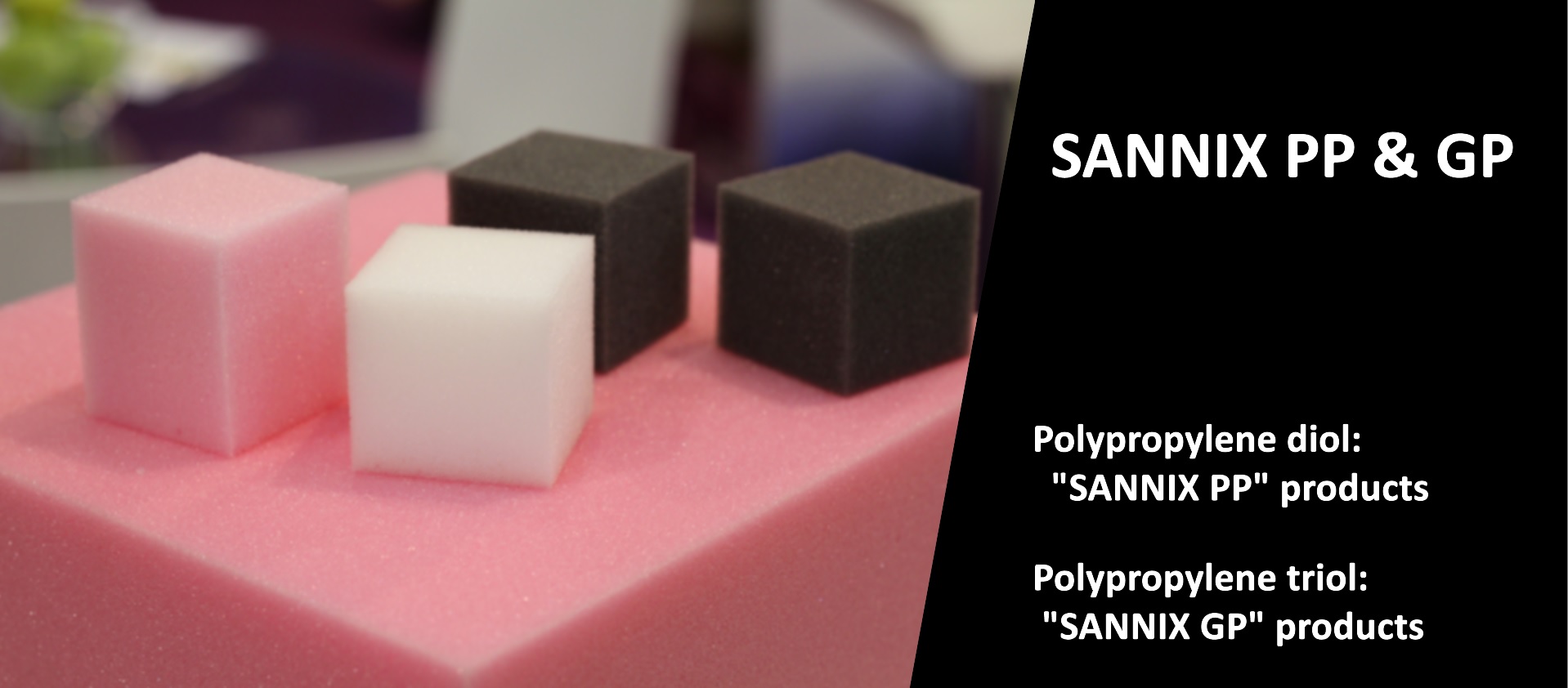
What's great about Sanyo Chemical's polypropylene glycol (PPG) "SANNIX PP, GP"
1
World-class technology and Japan's top-class production capacity
In 1960, we developed Japan's first polyether polyol for polyurethane foam and launched it on the market under the trademark "SANNIX. Since then, we have developed a variety of polyether polyols for polyurethane foams for various applications, including ultra-soft, soft, semi-hard, and hard foams, and they have been well received.
"SANNIX", produced by our world-class technology and Japan's top-class production capacity, is used by most polyurethane foam manufacturers in Japan, and is also widely used overseas.
2
Full lineup for each application
Both the "SANNIX PP" products of polypropylene diols and the "SANNIX GP" products of polypropylene triols are available in a wide range of molecular weights, making it possible to select one for each application.
Structural formula of polypropylene glycol (PPG) "SANNIX PP, GP" products
SANNIX PP products (polypropylene glycol diol type) general formula
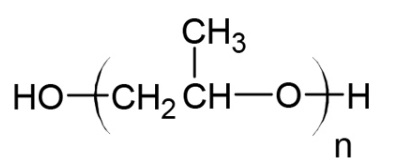
SANNIX GP products (polypropylene glycol triol type) general formula

About Polyurethane
Polyether polyol and urethanation reaction
Polyurethanes are polymers obtained by reacting polyol components such as polyether polyol and polypropylene glycol (PPG) with polyisocyanate components.
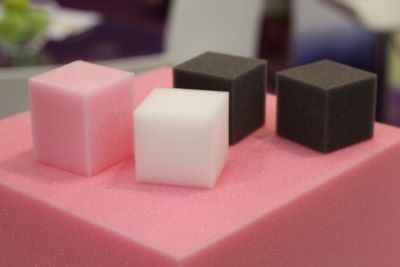
Urethanation reaction (resin generating reaction)

Physical Properties of Polyurethane
Below are the cohesive energies (unit: kcal/mol) of various molecular structures.
It can be seen that urethane bonds have higher cohesive force than other molecular structures.
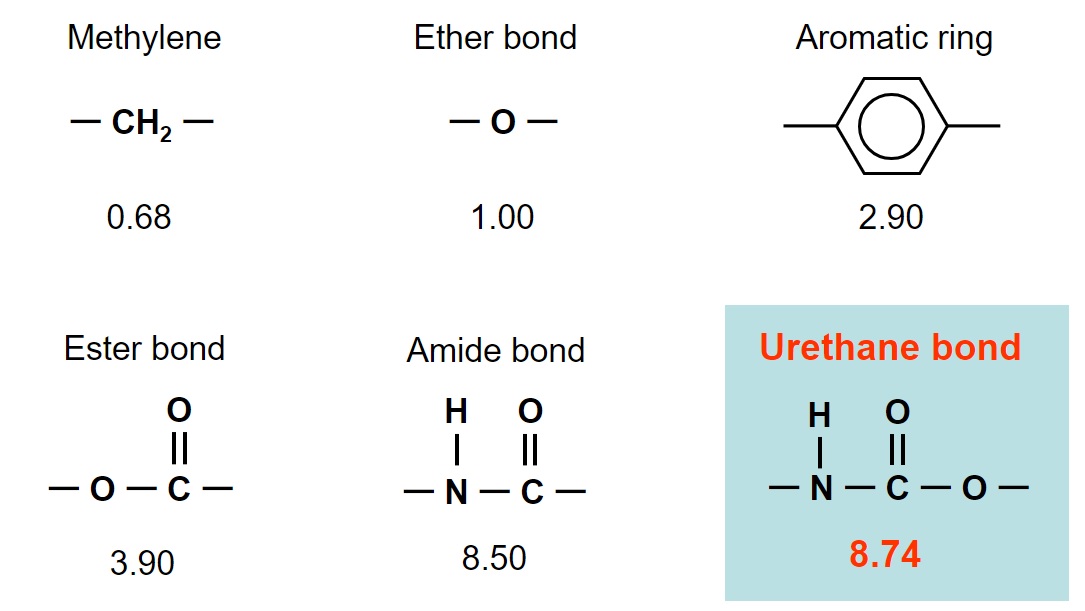
Urethane resins are synthesized by the reaction of polymer polyols such as polypropylene glycol (PPG) and isocyanate. It is known that the amorphous polyol component forms the "sea" of soft segments, while the urethane bonds with high cohesive energy form the "islands" of hard segments. The high cohesive energy of the hard segment results in the formation of a "sea" of soft segments. The high cohesive energy of the hard segment provides adhesion to the base material, while the soft segment makes it possible to design a product that also has the ability to follow the base material.
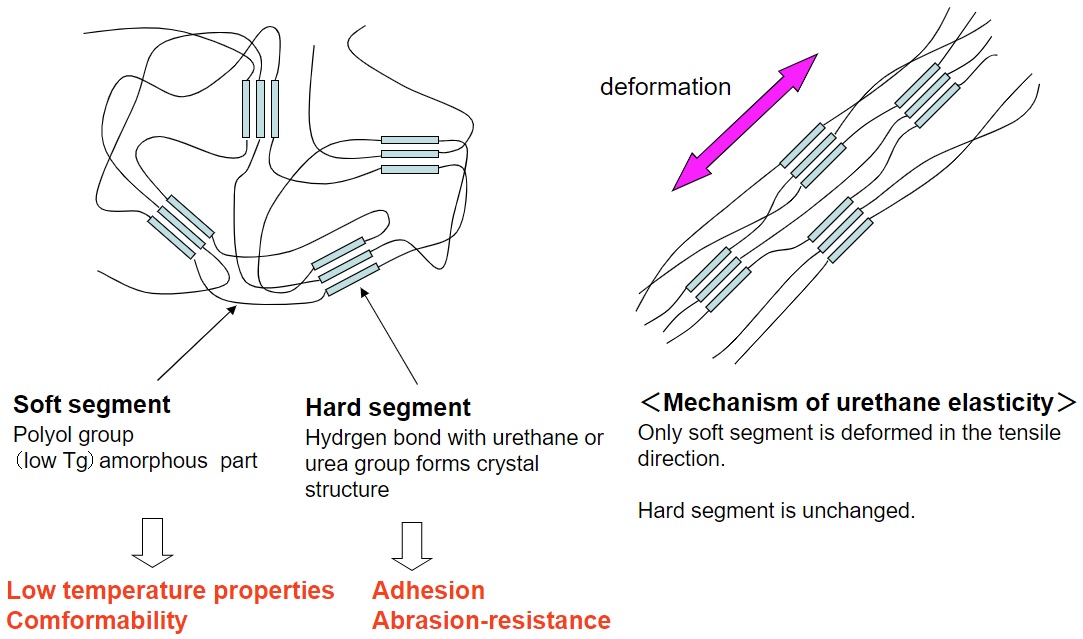
Main lineup of Sanyo Chemical's polypropylene glycol (PPG) "SANNIX PP, GP" products
"SANNIX PP" products (polypropylene glycol diol type)
| Appearance (20±5℃) |
Hydroxyl value | Specific gravity (20℃/20℃) |
Viscosity mPa・s (25℃) |
Flash point *1 ℃ |
pH *2 | |
|---|---|---|---|---|---|---|
| SANNIX PP-200 | Colorless liquid | 560 | 1.020 | 60 | 135 | 6.0 |
| SANNIX PP-400 | Colorless liquid | 280 | 1.013 | 70 | 180 | 6.0 |
| SANNIX PP-600 | Colorless liquid | 187 | 1.011 | 85 | 225 | 6.5 |
| SANNIX PP-950 | Colorless liquid | 118 | 1.009 | 140 | 230 | 6.5 |
| SANNIX PP-1000 | Colorless liquid | 112 | 1.009 | 145 | 230 | 6.5 |
| SANNIX PP-1200 | Colorless liquid | 98 | 1.008 | 165 | 235 | 6.5 |
| SANNIX PP-2000 | Colorless liquid | 56 | 1.006 | 305 | 240 | 6.5 |
| SANNIX PP-3000 | Colorless liquid | 35 | 1.005 | 590 | 226 | 6.5 |
| SANNIX PP-4000 | Colorless liquid | 27 | 1.004 | 990 | 228 | 6.5 |
"SANNIX GP" products (polypropylene glycol triol type)
| Appearance (20±5℃) |
Hydroxyl value | Specific gravity (20℃/20℃) |
Viscosity mPa・s (25℃) |
Flash point *1 ℃ |
pH *2 | |
|---|---|---|---|---|---|---|
| SANNIX GP-250 | Colorless liquid | 670 | 1.088 | 950 | 189 | 6.0 |
| SANNIX GP-400 | Colorless liquid | 400 | 1.055 | 365 | 218 | 6.5 |
| SANNIX GP-600 | Colorless liquid | 280 | 1.042 | 275 | 226 | 6.5 |
| SANNIX GP-1000 | Colorless liquid | 160 | 1.025 | 255 | 228 | 6.5 |
| SANNIX GP-1500 | Colorless liquid | 112 | 1.020 | 300 | 228 | 6.5 |
| SANNIX GP-3000 | Colorless liquid | 56 | 1.012 | 500 | 230 | 6.5 |
| SANNIX GP-4000 | Colorless liquid | 42 | 1.011 | 660 | 235 | 6.5 |
Viscosity-temperature characteristics of Sanyo Chemical's polypropylene glycol (PPG) "SANNIX PP, GP" products
The viscosity-temperature curves for the "SANNIX PP" products (polypropylene glycol diol type)
and "SANNIX GP" product (polypropylene glycol triol type) are shown below.
"SANNIX PP" products (polypropylene glycol diol type)
Viscosity-temperature curve of "SANNIX PP" products (polypropylene glycol diol type)

"SANNIX GP" products (polypropylene glycol triol type)
Viscosity-temperature curve of "SANNIX GP" products (polypropylene glycol triol type)

Precautions for use
Before handling this product, be sure to read the "Safety Data Sheet" (SDS) for this product and its sub-materials (chemicals). The SDS can be obtained here. https://www.sanyo-chemical.co.jp/products/en/sds/
Related Information
Related products
- Polyether related products
-
Polyethylene glycol "PEG"
Polyether with allyl group "SANYCOL"
- Polyurethane related products
Polyurethane pressure sensitive adhesive "POLYTHICK UP"
Polyurethane tooling boards "SANMODUR"
-
Links to Sanyo Chemical's corporate site
-
"SANNIX PP" products (polypropylene glycol diol type)
SANNIX PP-200, SANNIX PP-400, SANNIX PP-600, SANNIX PP-950, SANNIX PP-1000
SANNIX PP-1200, SANNIX PP-2000, SANNIX PP-3000, SANNIX PP-4000
"SANNIX GP" products (polypropylene glycol triol type)
SANNIX GP-250, SANNIX GP-400, SANNIX GP-600, SANNIX GP-1000
SANNIX GP-1500, SANNIX GP-3000, SANNIX GP-4000
SANNIX GP-3000R, SANNIX GP-3700M
Products search
This page has been prepared solely for information purposes.
Sanyo Chemical Industries, Ltd. extends no warranties and makes no representations as to the accuracy or completeness of the information contained herein, and assumes no responsibility regarding the suitability of this information for any intended purposes or for any consequences of using this information.
Any product information in this brochure is without obligation and commitment, and is subject to change at any time without prior notice.
Consequently anyone acting on information contained in this brochure does so entirely at his/her own risk.In particular, final determination of suitability of any material described in this brochure, including patent liability for intended applications, is the sole responsibility of the user. Such materials may present unknown health hazards and should be used with caution. Although certain hazards may be described in this brochure, Sanyo Chemical Industries, Ltd. cannot guarantee that these are the only hazards that exist.





